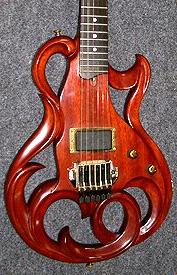 A luthier made an ornate one-of-a-kind electric guitar body in the early 1980s and wanted to document his classic creation and create an updated version based on his 20-plus years of experience in the guitar making field – in order to do this he needed an exact 3D CAD model of the instrument only 3D scanning could provide.
A luthier made an ornate one-of-a-kind electric guitar body in the early 1980s and wanted to document his classic creation and create an updated version based on his 20-plus years of experience in the guitar making field – in order to do this he needed an exact 3D CAD model of the instrument only 3D scanning could provide.
The Challenge:
The guitar maker (luthier) began making custom guitars in the late 1970s. He made an especially ornate one-of-a-kind electric guitar body in the early 1980s. Many professional musicians had played it and given it rave reviews. The luthier decided that he wanted to document his classic creation and create an updated version based on his 20-plus years of experience in the guitar making field that could be produced in limited quantities with computer numerical controlled (CNC) machine tools at a local woodworking shop. This was the most complicated guitar body the luthier had ever made and the most complicated project the woodworking company had ever done, and it required an exact 3D CAD model of the instrument.
However, the luthier was stymied in his attempts to obtain useful dimensional information. The shape, the cut-outs, and the wood were all very unique and free-form, so reproducing a precise copy by hand would be impossible. He had already tried laser scanning with a company with low-end scanners that did not provide adequate data for the CNC process. Luckily, a colleague referred the luthier to Laser Design and their high-quality, high-precision 3D laser scanning.
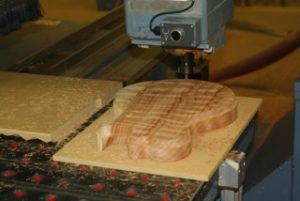 The Process:
The Process:
Laser Design has scanned its share of fine instruments over the years. Reasons ranged from wanting to reproduce or mass produce an especially noteworthy instrument to simply saving an instrument’s 3D dimensions for posterity. In the process, an amazing 3D digital model is created.
The luthier was impressed with Laser Design’s work when he saw a sample 3D model and decided to have the company re-do the previous unusable laser scanning work. “We got lucky when we found Laser Design through a personal connection,” he reported. He sent just the body of the guitar (no neck or hardware) to Laser Design for 3D scanning.
Laser Design engineers scanned the elaborate instrument on the Laser Design SURVEYOR™ 3D laser scanning system with the high-accuracy Laser Design SLP-500 laser line scanning probe (with accuracies of up to 0.011mm and 0.005mm resolution). Because the laser scanning system projects a line of laser light onto all of the part’s surfaces while cameras continuously triangulate the changing distance and profile of the laser line as it sweeps along, the problems of missing data on a complex free-form surface are greatly reduced. The laser line moves back and forth over the part until the complete area is captured digitally. The system measures fine details so that the object can be exactly replicated in a CAD model. Laser scanners measure articles quickly, picking up to 75,000 coordinate points per second, and generate huge numbers of data points without the need for special templates or fixtures.
Since the body of the electric guitar had no internal cavity, the scan reproduced the entire part’s profile completely and precisely. The set-up and scanning took just 3 hours. Because of the guitar’s complex shapes, clean-up and modeling took another 3 hours to make NURBS surfaces suitable for translating into files usable on the CNC machine.
As mentioned earlier, the luthier had tried another laser scanning company first, but there were large gaps in their scan data. Had he taken this initial inadequate data to the woodworking company, he would have had to spend an estimated $7,000-$10,000 to have the data files programmed to make it usable in the CNC. The excellent scan data produced by Laser Design erased this cost completely and it was produced in just two days vs. 3 weeks! The CNC toolpath was created from the original Laser Design data file, saving the luthier the cost of programming and data “creation” to fill in the gaps, the time that process would have taken on top of the already extended turnaround from the other company. Ironically, the unusable scan data cost him the same as the superior scan data from Laser Design.
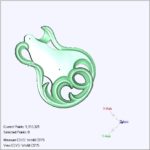 |
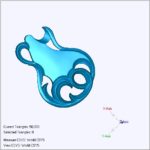 |
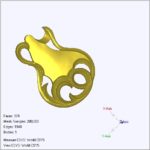 |
The Results:
The scan results were stunning. “Laser scanning is an amazing technology,” the luthier commented. “The toolpaths created directly from the Laser Design data files worked flawlessly. The whole scanning process worked out really well and the instrument was beautiful. Laser Design is so efficient, I had my clean usable data files back in only two days.
The woodworking shop was able to CNC the new body with the Laser Design-produced data without a hitch. First they made the wood cut-out through from the back. Then they used a jig to hold the piece in place from the back while the front was routed. One pass created the rough cut in about 5 minutes; the second pass gave almost user-ready precision in 25 minutes. The luthier ultimately wants to make 36 copies, about half of them from a rare mahogany wood. He will finish the pieces with some minor hand work to insure that each one is unique. “I see all sorts of applications for this high-precision laser scanning technology. This project worked so well, I’m very glad we got hooked up.”
